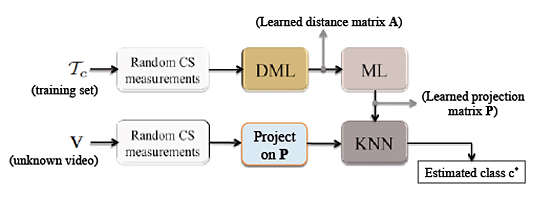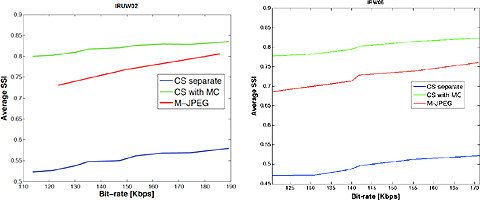|
|
Compressed Video Sensing |
|
Lightweight remote imaging systems have been increasingly used in surveillance and reconnaissance. Nevertheless, the limited power, processing and bandwidth resources is a major issue for the existing solutions, not well addressed by the standard video compression techniques. On the one hand, the MPEGx family achieves a balance between the reconstruction quality and the required bit-rate by exploiting potential intra- and interframe redundancies at the encoder, but at the cost of increased memory and processing demands. On the other hand, the M-JPEG approach consists of a computationally efficient encoding process, with the drawback of resulting in much higher bit-rates. |
|
|
The proposed CS based architecture copes with the growing compression ratios, required for all remote imaging applications, by exploiting the inherent property of compressive sensing (CS), acting simultaneously as a sensing and compression framework. The proposed compressive video sensing (CVS) system incorporates the advantages of a very simple CS-based encoding process, while putting the main computational burden at the decoder combining the efficiency of a motion compensation procedure for the extraction of inter-frame correlations, along with an additional super-resolution step to enhance the quality of reconstructed frames. The experimental results reveal a significant improvement of the reconstruction quality when compared with M-JPEG, at equal or even lower bit-rates. |
|
ORION members involved: George Tzagkarakis, Arnaud Woiselle , Panagiotis Tsakalides and Jean-Luc Starck [7]. |
|
Compressed Video Classification |
|
We introduce an architecture for addressing the problem of video classification based on a set of compressed features, without the need of accessing the original full-resolution video data. In particular, the video frames are acquired directly in a compressed domain by means of random projections associated with a set of compressive measurements. This initial dimensionality reduction step is followed by distance metric learning for the construction of an informative distance matrix, which is then embedded in a manifold learning approach to increase the discriminative power of the random measurements in a lower-dimensional space. Classification results using a set of activity videos suggest that the proposed approach can be used effectively in cases when the acquisition and processing of full-resolution video data is characterized by increased consumption of the available power, memory and bandwidth, which may impede the operation of systems with limited resources. |
|
 |
 |
ORION members involved: George Tzagkarakis, Grigorios Tsagkatakis, Jean-Luc Starck and Panagiotis Tsakalides [8], [11]. |
|
Compressed Sensing for Remote Imaging in Aerial and Terrestrial Surveillance
ACHIEVEMENTS



